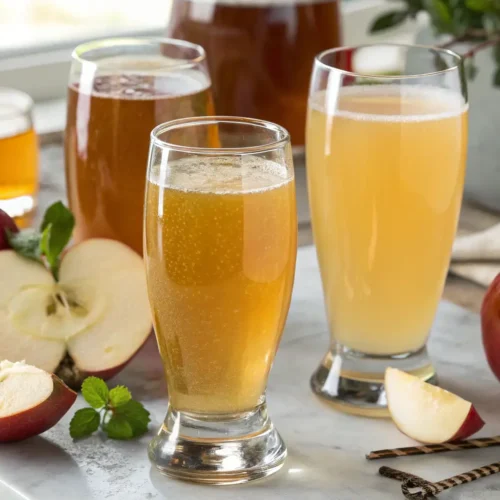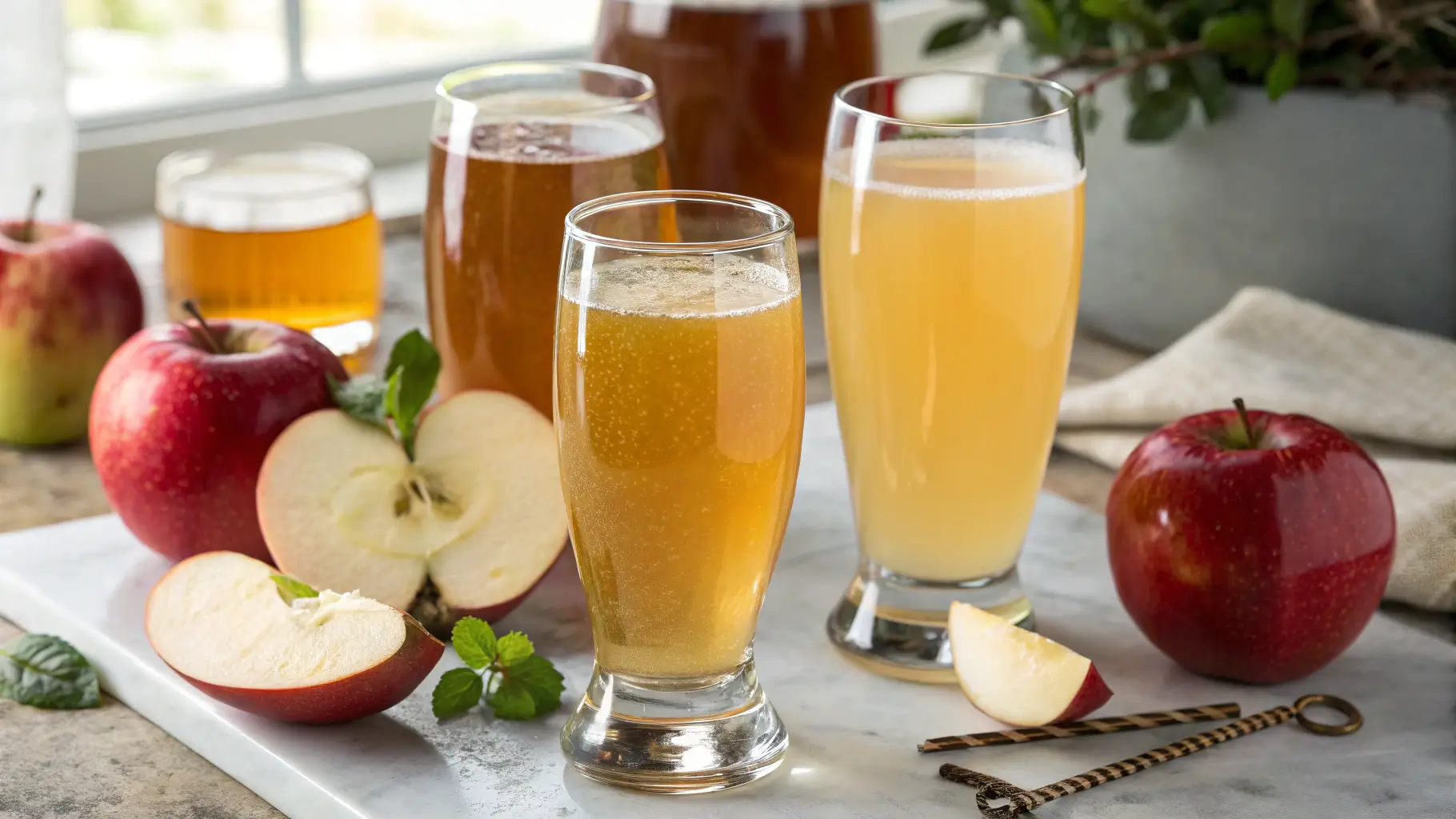Apple juice is far more diverse than many people realize. From crystal-clear commercial varieties to cloudy artisanal blends, the world of apple juice offers a fascinating spectrum of flavors, textures, and nutritional profiles. Whether you’re a health enthusiast, a parent looking for wholesome options for your children, or simply a culinary explorer, understanding the different apple juice types can enhance your appreciation and guide your choices. As someone who has experimented with countless homemade fruit juices over the years, I’m excited to share this comprehensive guide to the wonderful world of apple juice varieties.
In this article, we’ll explore everything from traditional and commercial apple juice types to specialty and international varieties. You’ll learn about production methods that affect flavor, nutritional differences between varieties, and even how to make your own apple juice at home. So grab a glass of your favorite apple juice, and let’s dive into this refreshing topic!
Table of Contents
The Main Apple Juice Types Based on Processing Methods
The way apple juice is processed significantly influences its taste, appearance, and nutritional value. Here’s a breakdown of the main apple juice types based on how they’re processed:
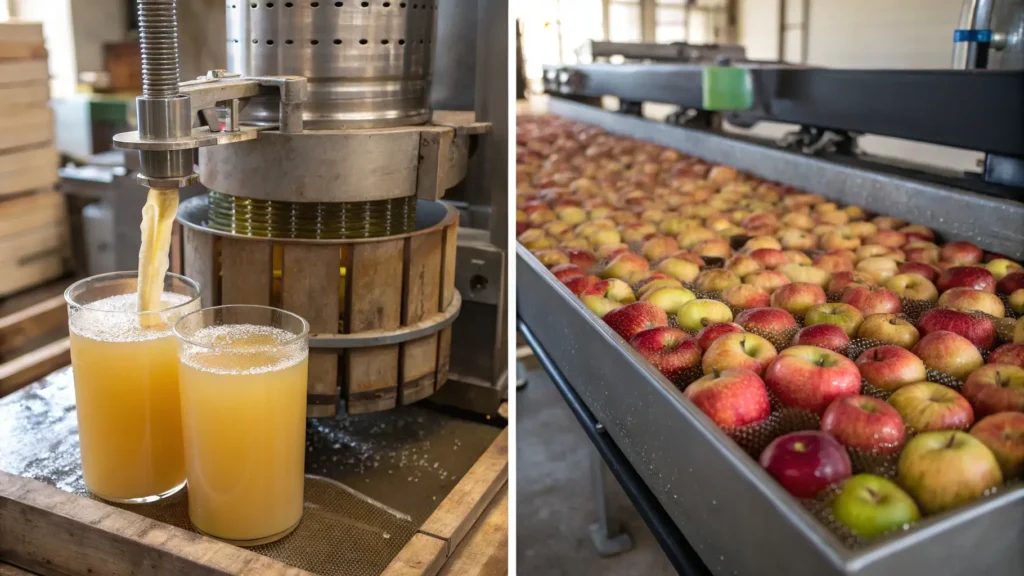
Filtered vs. Unfiltered Apple Juice
The most basic distinction between apple juice types comes from filtration:
Filtered Apple Juice
This is the clear, transparent apple juice commonly found in supermarkets. During production, the juice undergoes extensive filtration to remove pulp, sediment, and other solid particles. The result is a visually appealing, smooth juice with a consistent texture. While appealing to the eye, the filtration process unfortunately removes some of the beneficial fiber and nutrients found in whole apples.
Unfiltered Apple Juice (Cloudy Apple Juice)
Unfiltered apple juice maintains small particles of apple pulp, giving it a cloudy appearance. This type of apple juice is closer to its natural state and retains more of the nutritional benefits of whole apples, including dietary fiber and polyphenols. The flavor is often described as more robust and authentic compared to filtered varieties. Many artisanal and organic apple juice products fall into this category.
According to a study published in the Journal of Agricultural and Food Chemistry, cloudy apple juice contains up to four times more polyphenols than clear apple juice, making it potentially more beneficial for health.
Pasteurized vs. Fresh-Pressed Apple Juice
Another important distinction between apple juice types relates to preservation methods:
Pasteurized Apple Juice
Most commercially available apple juices undergo pasteurization, a process that heats the juice to kill harmful bacteria and extend shelf life. While this makes the product safer and more convenient, pasteurization can alter the flavor profile and reduce some heat-sensitive nutrients. The intensity of pasteurization varies across products, with some using gentler methods to better preserve flavor and nutrients.
Fresh-Pressed (Raw) Apple Juice
Fresh-pressed or raw apple juice hasn’t undergone pasteurization and is typically consumed shortly after pressing. This type of apple juice offers the most authentic apple flavor and maximum nutritional value. However, it has a very short shelf life (typically just a few days when refrigerated) and carries a small risk of bacterial contamination. You’ll most commonly find fresh-pressed apple juice at farmers’ markets, orchards, or specialty juice bars.
Common Commercial Apple Juice Types
When browsing store shelves, you’ll encounter several types of commercial apple juice products:
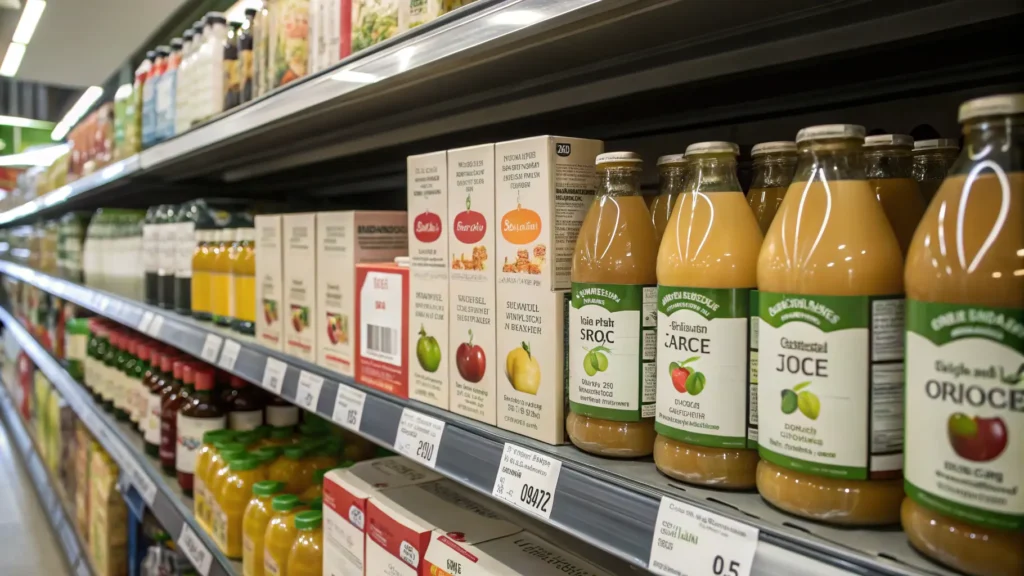
100% Pure Apple Juice
As the name suggests, this type of apple juice contains only pressed apples without added ingredients. However, even within this category, there can be significant differences in quality depending on the apples used, processing methods, and whether concentrates are involved. Premium 100% apple juices often specify the apple varieties used and may feature “not from concentrate” on their labels.
Apple Juice from Concentrate
Many commercial apple juice products are made from concentrate. In this process, most water is removed from fresh apple juice to create a concentrated form that’s easier and cheaper to transport. Before packaging, water is added back to reconstitute the juice. While perfectly safe, juice from concentrate often lacks the vibrant flavor of fresh-pressed versions. Many consumers report being able to taste the difference between concentrate and non-concentrate juice types.
Apple Juice Blends
These products combine apple juice with other fruit juices to create unique flavor profiles. Common blends include apple-grape, apple-cranberry, and apple-cherry. The percentage of actual apple juice in these blends varies widely, so checking the ingredient list is important if you’re specifically seeking apple nutrition.
Apple Juice Cocktails and Drinks
Products labeled as “cocktail,” “drink,” or “beverage” typically contain less actual juice and more added ingredients like sweeteners, flavors, or water. These products might contain as little as 10% real apple juice and are generally considered less nutritious than 100% juice options.
If you’re looking for the healthiest apple juice types, I recommend checking out my article on the benefits of daily juice consumption for more insights into incorporating fruit juices into a balanced diet.
Specialty and Artisanal Apple Juice Types
Beyond mass-market varieties, there’s a fascinating world of specialty apple juice types worth exploring:
Single-Variety Apple Juices
Like wine made from specific grape varieties, single-variety apple juices are pressed from just one type of apple. These specialty juices showcase the distinct characteristics of particular apple cultivars:
- Honeycrisp Apple Juice – Known for its perfect sweet-tart balance and honey-like notes
- Granny Smith Apple Juice – Distinctly tart and refreshing
- Fuji Apple Juice – Intensely sweet with floral undertones
- Pink Lady Apple Juice – Complex flavor with a good balance of sweetness and acidity
- Golden Delicious Apple Juice – Mild and sweet with honey notes
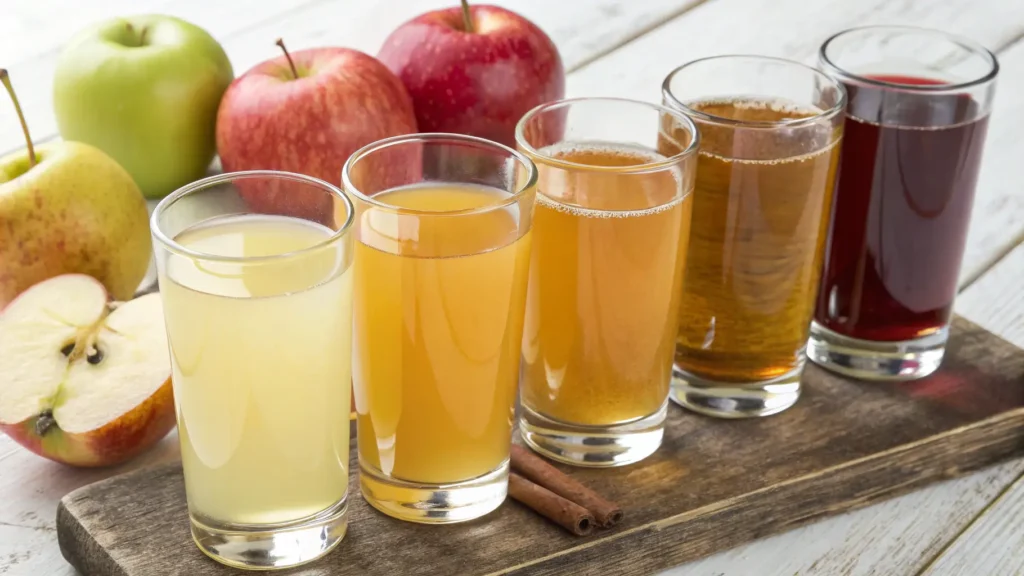
Organic Apple Juice
Organic apple juice is produced from apples grown without synthetic pesticides, herbicides, or fertilizers. Many consumers choose organic apple juice types to avoid potential pesticide residues, as conventional apples are among the fruits most heavily treated with pesticides. Organic apple juice often has a more authentic flavor profile and may contain higher levels of certain antioxidants compared to conventional varieties.
Cold-Pressed Apple Juice
Cold-pressed juicing is a method that doesn’t generate heat during extraction, which helps preserve heat-sensitive nutrients and enzymes. This process typically uses a hydraulic press to extract juice with minimal oxidation. Cold-pressed apple juice varieties tend to have brighter flavors and potentially higher nutritional value than juices extracted using centrifugal methods that generate heat.
Apple Cider vs. Apple Juice
While technically different beverages, apple cider and apple juice are often confused. In the United States, apple cider typically refers to unfiltered, unpasteurized apple juice, often with a stronger, more complex flavor. It has a shorter shelf life and may naturally ferment over time. In contrast, the term “apple juice” usually denotes the filtered, pasteurized product with longer shelf stability. In other countries, “cider” may specifically refer to the alcoholic fermented beverage.
If you enjoy experimenting with different fruit drinks, you might also be interested in my guide to creating perfect frozen beverages using various juice types.
International Apple Juice Varieties
Different regions around the world have their own traditional apple juice varieties and processing methods:
European Apple Juice Traditions
In countries like France, Germany, and the UK, apple juice production is often tied to cider-making traditions. European apple juice varieties frequently use specific regional apple cultivars and traditional pressing methods. Many European apple juices are less sweet than their American counterparts, with more complex flavor profiles highlighting acidity and tannins.
Asian Apple Juice Varieties
Japan and Korea produce distinctive apple juice types, often made from local apple varieties like Fuji and Aomori. These juices tend to emphasize the natural sweetness of the fruit with minimal processing. In some Asian markets, apple juice is also available in unique formats like jelly drinks or as an ingredient in tea-based beverages.
Middle Eastern Apple Juice
In countries like Turkey and Iran, apple juice often incorporates spices such as cinnamon, cardamom, or rosewater. These flavored apple juice varieties offer complex and unique taste experiences that reflect regional culinary traditions.
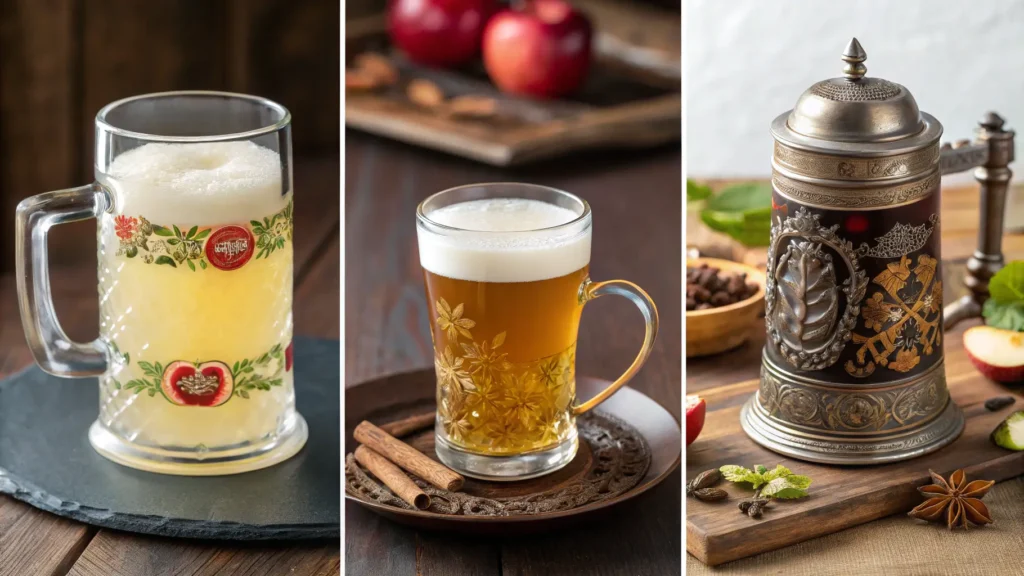
Nutritional Comparison of Different Apple Juice Types
Not all apple juice varieties offer the same nutritional benefits. Here’s how they compare:
| Apple Juice Type | Calories (8oz) | Sugar (g) | Fiber | Polyphenols | Vitamin C |
|---|---|---|---|---|---|
| Filtered Commercial | 110-120 | 24-28 | Very Low | Low | Moderate* |
| Unfiltered/Cloudy | 110-130 | 24-28 | Moderate | High | Moderate-High |
| Fresh-Pressed | 110-130 | 24-30 | Moderate | High | High |
| From Concentrate | 110-120 | 24-28 | Very Low | Low | Low-Moderate* |
| Organic Unfiltered | 110-130 | 24-28 | Moderate | Very High | Moderate-High |
*Often fortified with vitamin C during processing
From a nutritional standpoint, unfiltered, fresh-pressed, and organic apple juice varieties generally offer more health benefits due to their higher content of polyphenols and natural antioxidants. However, it’s important to remember that all apple juice types are relatively high in natural sugars and should be consumed in moderation as part of a balanced diet.
How to Make Homemade Apple Juice
Creating your own apple juice at home allows you to customize the flavor and control exactly what goes into your beverage. Here’s my favorite method for making homemade apple juice:
Homemade Fresh-Pressed Apple Juice Recipe
Ingredients:
- 10-12 medium apples (mix of sweet and tart varieties for best flavor)
- 1-2 tablespoons fresh lemon juice (optional, helps prevent browning)
- 1-2 teaspoons cinnamon or other spices (optional)
- 1-2 tablespoons honey or maple syrup (optional, for additional sweetness)
- Water as needed
Equipment Needed:
- Juicer or food processor
- Fine mesh strainer or cheesecloth
- Large bowl
- Storage bottles
Instructions:
- Prepare the apples: Wash the apples thoroughly. For most juicers, quarter the apples and remove the cores. If using sweeter apple varieties, the cores can sometimes impart bitterness.
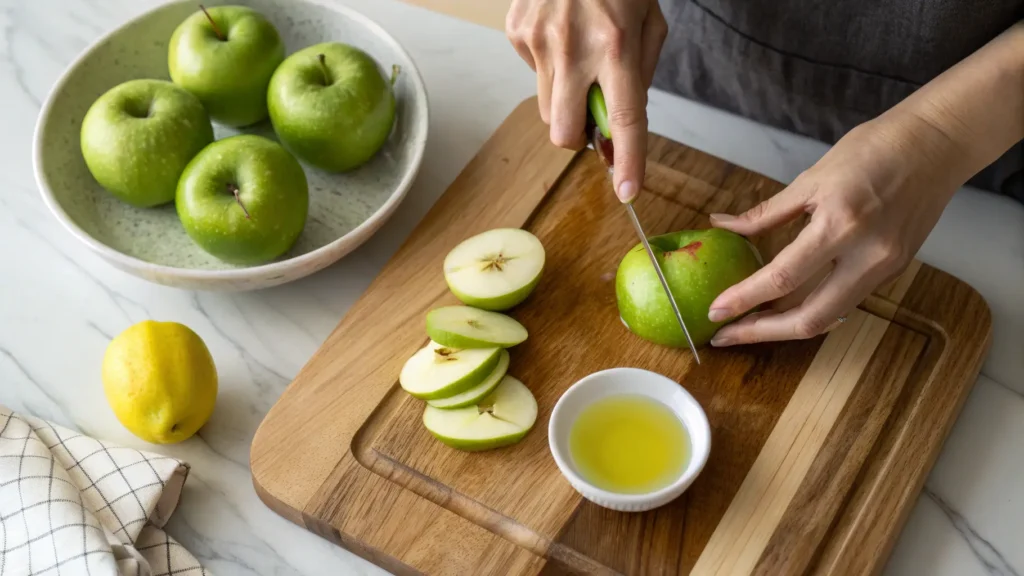
- Juice the apples: If using a juicer, feed the apple pieces through according to your juicer’s instructions. If using a food processor, pulse the apples until finely chopped, then strain through cheesecloth or a fine mesh strainer, pressing to extract as much juice as possible.
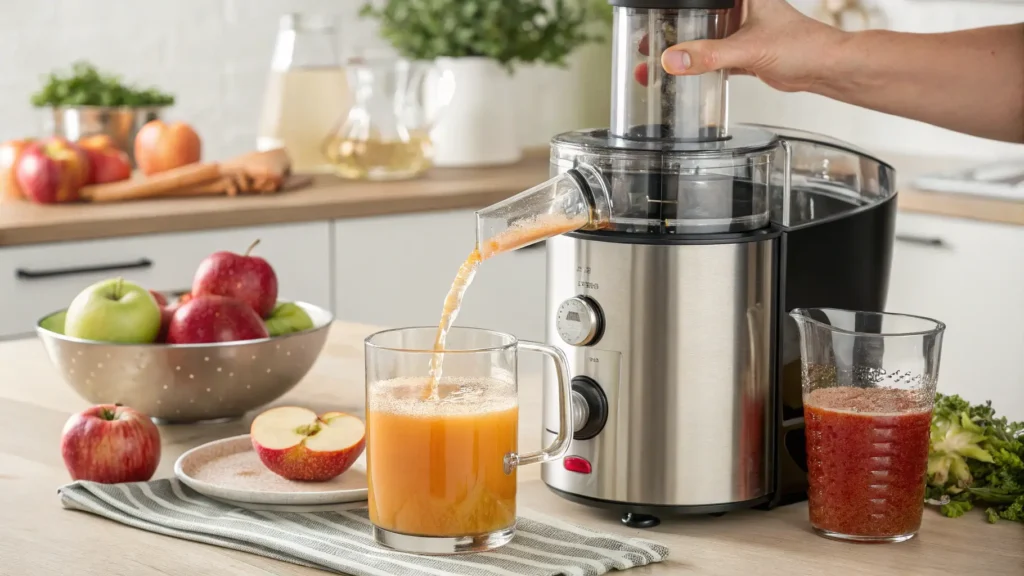
- Strain if desired: For clearer juice, strain the liquid through a fine mesh strainer or cheesecloth. For cloudy, more nutritious juice, skip this step or strain only lightly.
- Add optional ingredients: Stir in lemon juice to preserve color, and add spices or sweeteners if desired. The natural sweetness of the apples is usually sufficient, but honey or maple syrup can enhance the flavor.
- Serve or store: Serve immediately over ice for the freshest flavor. To store, transfer to airtight containers and refrigerate for up to 5 days. For longer storage, you can pasteurize the juice by heating it to 160°F (71°C) for 10 minutes, then bottle in sterilized containers.
Tips for Creating Different Homemade Apple Juice Types:
- For sweeter juice: Use varieties like Fuji, Gala, or Red Delicious
- For more complex flavor: Mix sweet and tart varieties like Honeycrisp and Granny Smith
- For spiced apple juice: Add cinnamon sticks, star anise, or cloves during straining
- For apple-ginger juice: Add 1-2 inches of fresh ginger while juicing
Creating your own apple juice at home connects you with traditional food preparation methods similar to other classic recipes. If you enjoy making things from scratch, you might also like my recipe for homemade hotcake mix – another staple that tastes infinitely better when made fresh.
Best Uses for Different Apple Juice Types
Different apple juice varieties excel in different culinary applications:
Drinking and Cocktails
For drinking straight, unfiltered or fresh-pressed apple juice offers the most authentic flavor. For cocktails, filtered apple juice works better in transparent drinks, while cloudy varieties add character to rustic cocktails like mulled cider or apple sangria.
Cooking with Apple Juice
When cooking with apple juice, consider these applications for different types:
- Marinades: Apple juice tenderizes meat and adds subtle sweetness. Try using it for pork or chicken marinades.
- Braising liquid: Add depth to braised dishes by replacing some or all of the cooking liquid with apple juice.
- Sauces: Reduce apple juice to create a flavorful base for sauces – tart varieties work best for this.
- Baking: Replace water or milk with apple juice in baking recipes for added flavor and natural sweetness.
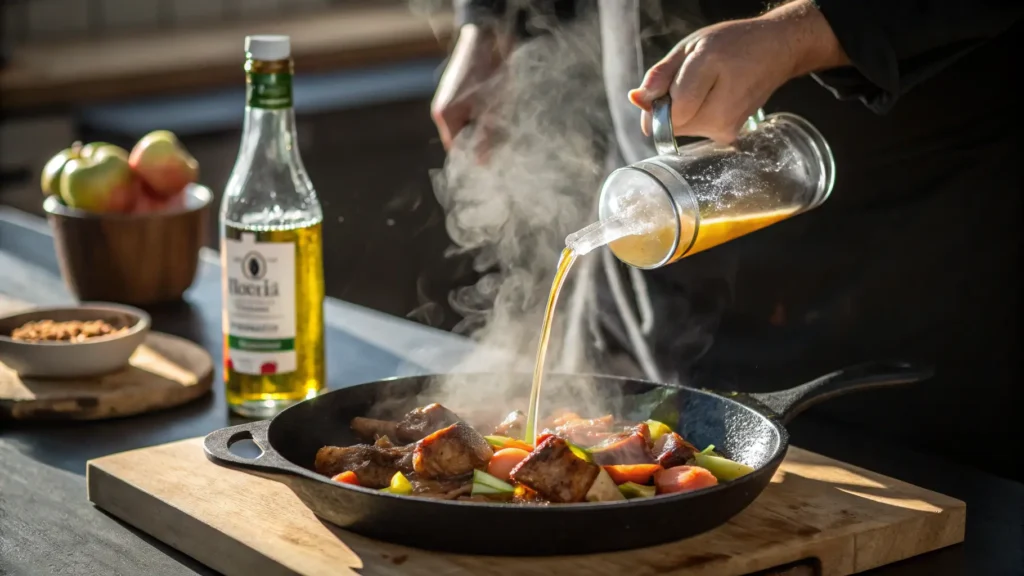
Baking with Apple Juice
In baking, apple juice can add moisture and flavor to cakes, muffins, and bread recipes. Reduced apple juice (boiled down to a syrup) makes an excellent glaze for pastries or natural sweetener for granola. When selecting apple juice for baking, consider these points:
- For subtle apple flavor, use filtered juice
- For more pronounced apple character, use reduced unfiltered juice
- For caramel notes, use juice made from sweeter apple varieties
Health Considerations for Different Apple Juice Types
When choosing apple juice for health reasons, consider these factors:
Sugar Content and Glycemic Impact
All apple juice types contain natural sugars – typically 24-30g per 8oz serving. While these are natural sugars, they can still impact blood glucose levels. Unfiltered juice with pulp has a slightly lower glycemic impact due to the presence of fiber that slows sugar absorption.
Antioxidant Content
According to research from the USDA Agricultural Research Service, cloudy apple juice contains significantly more antioxidants than clear varieties. The polyphenols and other beneficial compounds are most concentrated in the apple’s skin and flesh particles that remain in unfiltered juice.
Best Apple Juice Types for Children
For children, diluted apple juice can be a good occasional beverage. Pediatricians generally recommend:
- Limiting juice to 4-6oz per day for children ages 1-6
- Choosing 100% juice without added sweeteners
- Diluting juice with water (50/50) for young children
- Serving juice with meals rather than allowing constant sipping
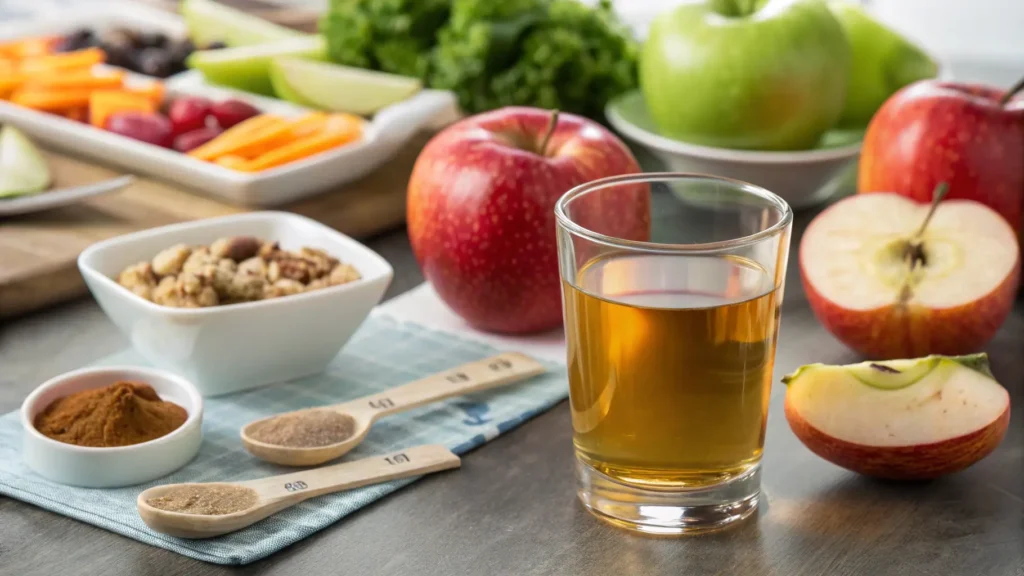
Frequently Asked Questions About Apple Juice Types
Which apple varieties make the best juice?
The best apple juice comes from a blend of varieties. Sweet apples like Fuji, Gala, and Red Delicious provide natural sweetness, while tart varieties like Granny Smith, Braeburn, and Pink Lady add complexity and balance. Commercial producers often use a proprietary blend of varieties to achieve consistent flavor profiles.
Is cloudy apple juice healthier than clear apple juice?
Yes, studies show that cloudy (unfiltered) apple juice contains up to four times more polyphenols and antioxidants than clear juice. The pulp in cloudy juice contains beneficial compounds that are removed during the filtration process used to create clear juice.
Can apple juice replace applesauce in recipes?
Apple juice can sometimes replace applesauce in recipes, but adjustments are necessary. Since juice is thinner, you’ll need to reduce other liquids or add a thickening agent. Reduced (concentrated) apple juice works better as an applesauce substitute in baking.
How can I tell if apple juice has gone bad?
Signs that apple juice has spoiled include: changes in color (darkening or browning), off or fermented smell, bubbling or fizzing (unless it’s a sparkling variety), mold growth, or changes in taste. Unopened commercial apple juice can last 6-12 months, while fresh-pressed varieties should be consumed within 3-7 days.
Is apple cider vinegar related to apple juice?
Yes, apple cider vinegar is made by fermenting apple juice. First, yeast is added to apple juice to convert sugars to alcohol (creating hard cider). Then, bacteria convert the alcohol to acetic acid, creating vinegar. The best apple cider vinegar is made from organic, unfiltered apple juice.
Can I freeze apple juice?
Yes, apple juice freezes well. Leave about 1 inch of headspace in the container as the juice will expand when frozen. Frozen apple juice can be stored for 8-12 months. Thaw in the refrigerator and shake or stir well before serving as some separation may occur.
Conclusion: Exploring the World of Apple Juice Types
The world of apple juice is remarkably diverse, offering something for every palate and purpose. From crystal-clear filtered commercial varieties to rustic, cloudy fresh-pressed juice, each type has its place in both culinary applications and everyday enjoyment. Understanding the differences between apple juice types allows you to make more informed choices based on your taste preferences, health considerations, and intended use.
I encourage you to experiment with different apple juice varieties in your cooking and drinking. Try making your own fresh-pressed juice at home, sample artisanal single-variety juices, or incorporate apple juice into your cooking for natural sweetness and depth of flavor. The versatility of apple juice makes it a wonderful ingredient to have on hand in any kitchen.
What’s your favorite type of apple juice? Do you prefer the clarity and smoothness of filtered varieties, or the robust character of unfiltered juice? Have you tried making your own at home? I’d love to hear about your experiences and preferred apple juice types in the comments below!
For more fruit-based recipes and beverage ideas, check out my other articles on creative apple desserts and refreshing homemade beverages.
